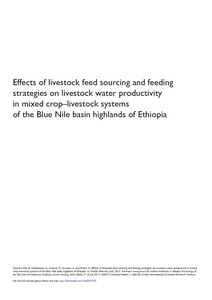Resource information
Inefficient management and use of water is unanimously the most single constraint of agricultural production of Ethiopia. The study was conducted to assess the effect of livestock feed sourcing and feeding strategies on livestock water productivity (LWP) in mixed crop–livestock production systems of the Blue Nile Basin in Ethiopian Highlands. Three districts representing diverse agricultural farming systems were considered. Each district further stratified to different farming systems. Multi-stage stratified random sampling technique was employed to select farm households. Household survey, group discussions and plant biomass sampling were done to generate data on beneficial outputs, water depleted and feed sourcing and feeding strategies. LWP was estimated as a ratio of livestock’s beneficial outputs and services to depleted water. The results indicated that the major feed sources were mainly from crop residues (58.5 to 78.2%), natural pasture (10.9 to 33.4%) and aftermath grazing (9.9 to 24.3%) in study farming systems. The feed source from energy dense (improved forages) was low. The feeding strategies were relatively similar among the study farming systems. No apparent difference (P>0.05) was observed in LWP within all districts among the farming systems and the value falls between USD 0.15–0.19 m-3. However, LWP difference was observed within clustered wealth status within all farming systems and lower value of LWP general observed for the poor farm households. Such differences of LWP values can be accounted for by the strategies farm households are following in feed sourcing and how water productive those feed sources are. Hence, in the context of this work, options to improve LWP mainly involve sourcing water productive and higher quality feed.



